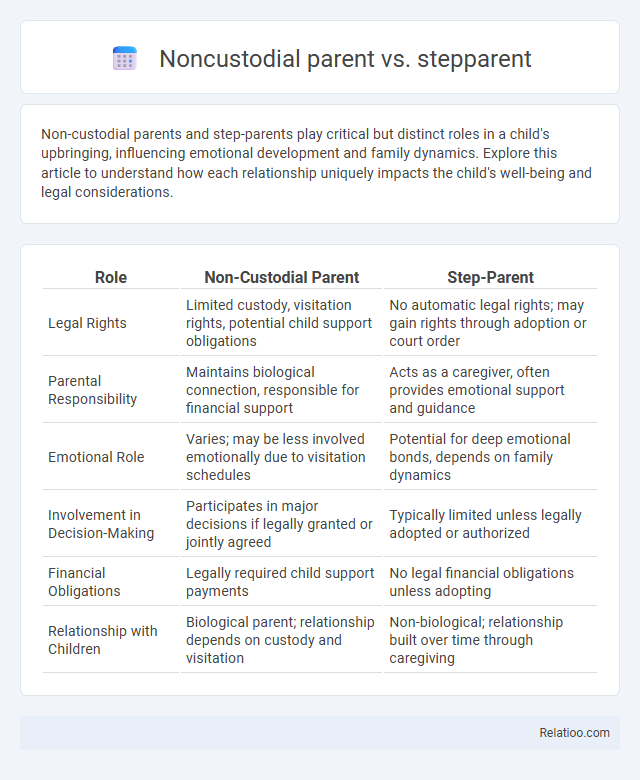Non-custodial parents and step-parents play critical but distinct roles in a child's upbringing, influencing emotional development and family dynamics. Explore this article to understand how each relationship uniquely impacts the child's well-being and legal considerations.
Table of Comparison
| Role | Non-Custodial Parent | Step-Parent |
|---|---|---|
| Legal Rights | Limited custody, visitation rights, potential child support obligations | No automatic legal rights; may gain rights through adoption or court order |
| Parental Responsibility | Maintains biological connection, responsible for financial support | Acts as a caregiver, often provides emotional support and guidance |
| Emotional Role | Varies; may be less involved emotionally due to visitation schedules | Potential for deep emotional bonds, depends on family dynamics |
| Involvement in Decision-Making | Participates in major decisions if legally granted or jointly agreed | Typically limited unless legally adopted or authorized |
| Financial Obligations | Legally required child support payments | No legal financial obligations unless adopting |
| Relationship with Children | Biological parent; relationship depends on custody and visitation | Non-biological; relationship built over time through caregiving |
Understanding Non-Custodial Parents
Non-custodial parents share legal responsibilities but do not live primarily with their children, often maintaining contact through visitation or custody arrangements; step-parents may have no legal rights unless adoption occurs. Understanding non-custodial parents involves recognizing their obligations for child support, emotional involvement, and the challenges they face in maintaining consistent relationships. Legal frameworks and family dynamics vary, influencing the role and rights of non-custodial parents in child-rearing decisions.
Defining the Role of Step-Parents
Step-parents play a unique role in a child's life by providing emotional support, guidance, and stability without holding legal custody or primary decision-making authority. Unlike non-custodial parents, step-parents typically do not have inherent custody rights but can contribute to the child's well-being through nurturing relationships and cooperation with custodial parents. Establishing clear boundaries and responsibilities helps define the step-parent's involvement while respecting the roles of both custodial and non-custodial parents.
Legal Rights and Responsibilities
Non-custodial parents typically retain legal rights such as visitation and decision-making on major issues like education and healthcare despite not living with the child. Step-parents generally do not have automatic legal rights or responsibilities unless they legally adopt the child or obtain court authorization. Your legal obligations depend on custody agreements and court orders, which define financial support and parental involvement for non-custodial parents, while step-parents usually lack those duties unless formally recognized.
Emotional Impact on Children
The emotional impact on children varies significantly between relationships with non-custodial parents, step-parents, and custodial parents, influencing their sense of stability and attachment. Children may experience feelings of loss, confusion, or divided loyalty when engaging with non-custodial parents, while relationships with step-parents can evoke a blend of acceptance and resistance depending on the quality of bonding and consistency. Healthy communication and emotional support within all parental roles are crucial for fostering secure attachments and mitigating potential emotional distress in children.
Co-Parenting Strategies
Non-custodial parents and step-parents often collaborate to create effective co-parenting strategies that prioritize the child's well-being and stability. Clear communication, consistent scheduling, and mutual respect are essential to navigate complex family dynamics and ensure cohesive parenting approaches. Utilizing mediation or family counseling can further enhance cooperation, reduce conflicts, and support the child's emotional needs in blended family environments.
Boundaries and Discipline
Non-custodial parents often face challenges establishing boundaries and discipline due to limited physical presence, relying on consistent communication and coordination with custodial parents to maintain authority. Step-parents must navigate unique dynamics by respecting existing parental roles while gradually implementing discipline that aligns with the child's established routines and family expectations. Effective boundary-setting in blended families hinges on cooperation and clear role definitions to support the child's emotional stability and behavioral consistency.
Communication Between Adults
Effective communication between non-custodial parents, step-parents, and custodial parents is essential for creating a stable environment for the child. Establishing clear boundaries and respectful dialogue helps reduce conflicts and ensures that your child's needs are prioritized during interactions. Consistent, transparent communication fosters trust and cooperation among all adults involved in the child's life.
Financial Obligations
Non-custodial parents typically have legally mandated financial obligations, including child support payments to contribute to the child's living expenses, education, and healthcare. Step-parents generally do not bear formal financial responsibilities for their stepchildren unless they legally adopt them or agree to support voluntarily. Non-custodial parents' financial obligations are enforceable by courts, ensuring consistent support, unlike the often informal and discretionary contributions of step-parents.
Building Healthy Relationships
Building healthy relationships between non-custodial parents, step-parents, and children requires clear communication, mutual respect, and consistent boundaries. Non-custodial parents benefit from maintaining regular involvement and supporting the child's emotional needs, while step-parents should foster trust through patience and open dialogue. Collaborative parenting strategies enhance stability and promote a positive family dynamic that prioritizes the child's well-being.
Navigating Common Challenges
Navigating common challenges between a non-custodial parent, step-parent, and non-custodial parent involves clear communication and respecting boundaries to foster a positive environment for the child. You must balance the custodial parent's authority with the involvement of the step-parent, ensuring the child's emotional well-being is prioritized. Establishing consistent routines and shared decision-making helps reduce conflicts and promote cooperation among all parties involved.

Infographic: Non-custodial parent vs Step-parent
 relatioo.com
relatioo.com